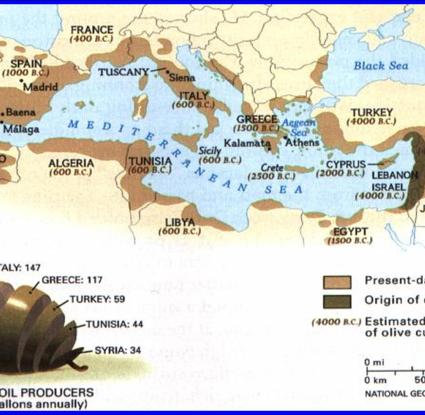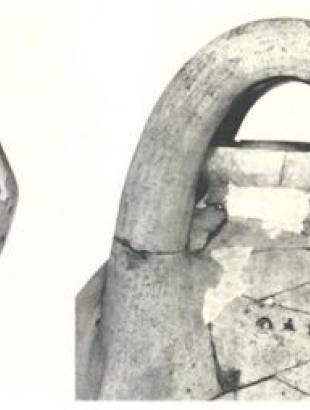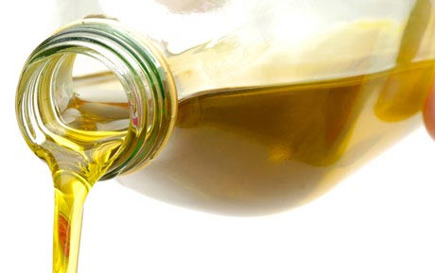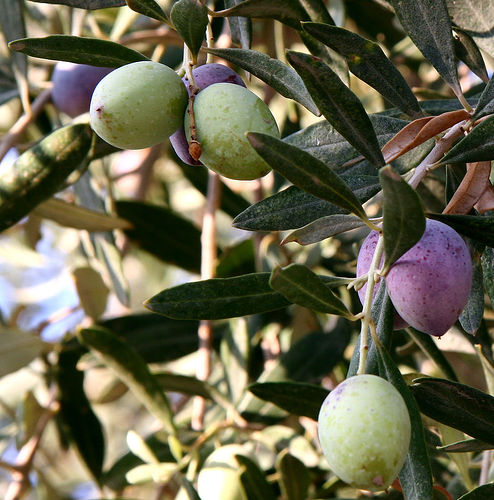Name - Origin
Ελαιόλαδο.
Picture 1 - Strabo (1st century BC) in his work 'Geographica' (14.5) refers to Cyprus's self-sufficiency in olive oil, describing Cyprus as 'εὐέλαιο' (evéleo).
Olive oil is produced by processing olives. Its use is not limited only to cooking or food but can be used as fuel for lighting, as a cosmetic and as a sacred offering to deities (Hadjisavvas 1996a, 129). Hadjisavvas, who has studied in detail the methods of production and the uses of olive oil, regards olive oil to have been as important to Cypriot society and economy as copper (Hadjisavvas 1992a, 233). The three main stages in the olive oil production process are a) crushing the olive fruit, b) pressing the olive pulp, c) separating the oil from the other substances (Hadjisavvas).
Additional information and bibliography
Some evidence supports that Cypriot olive oil was traded as a commercial product.
Pictures 1-2 - Letters of Amarna: Late Bronze Age Many researchers hold that 'Alasia' is identified with Cyprus or a region of Cyprus: if this assumption is valid, the first reference on the trade of Cypriot oil, according to Hadjisavvas (1992, 115-116), is found in the correspondence of Amarna. These are letters sent by the king of Alasia to the Pharaoh during the 18th Dynasty, during the first seven years of Akhenaten's reign (1352-1334 BC). Linear B: Late Bronze Age The tablets of the Mycenaean period which bear the inscription 'Linear B' offer, among other things, information about the commercial transactions of the Mycenaeans. In a series of clay tablets which have been found in Knossos (Palaima 1991, 274), the adjective ku-pi-ri-jo [=Cypriot(?)] is mentioned. The adjective seems to identify a range of products: wool, oil, honey, pottery and ointment ingredients (Palaima 1991, 281). The Fh series of these tablets has oil as its central theme, and thus the adjective ku-pi-ri-jo identifies this item.
Picture 3 - Inscription on an amphora: Cyproarchaic Era In the necropolis of Salamina, an amphora with a four-syllable inscription in Cypriot syllabary ‘ΕΛΑΙΩ’ was found in tomb no.3. The inscription indicates the contents of the amphora but, according to Masson, it probably also indicates the contents of other amphorae (oil or other similar products) found nearby that do not bear an inscription (Masson, 1967). The amphora dates to 600 BC (Winther-Jacobsen 2002, 173).
Bennett, E.L. et alii (1989) 436 Raccords et quasi-raccords de fragments inedits. Salamanca: Universidad de Salamanca.
Hadjisavvas, S. (1996) ‘The Economy of the Olive’ στο: Karageorghis, V.; Michaelides, D. (ed.) The Development of the Cypriot Economy- from the Prehistoric Period to the Present Day. Nicosia: University of Cyprus, 127-137.
Hadjisavvas, S. (1992) Olive-oil processing in Cyprus-from the Bronze Age to the Byzantine Period, Studies in Mediterranean Archaeology 99. Nicosia: Paul Astroms.
Hadjisavvas, S. (1992α) ‘Olive Oil Production and Divine Protection’ στο: Astrom, P. (ed.) Acta Cypria: Acts of the International Congress on Cypriot Archaeology held in Goteborg on 22-24 August 1991, part 3. Jonsered: Paul Astroms Forlag, 233-248.
Hellbing, L. (1979) Alasia Problems, Studies in Mediterranean Archaeology 57. Goteborg: Paul Astroms.
Jones, H.L. (translation) (1988) Strabo-The Geography of Strabo, Loeb Classical Library 223. Cambridge: Harvard University Press, v.6.
Masson, O. (1967) ‘Les Insciptions Syllabiques’ in: Karageorghis, V. Excavations in the Necropolis of Salamis. Nicosia: Department of Antiquities, 132-142.
Moran, W.L. (1992) Amarna Letters. London: John Hopkins University Press.
Palaima, T. (1991) ‘Maritime Matters in Linear B’ Tablets’ in: Laffiineur, R.; Basch, L. (ed.) Thalassa: L’Egee Prehistorique et la mer. Liege: Universite de Liege, 273-309.
Winther-Jacobsen, K. (2002) ‘Cypriot Transport Amporae in the Archaic and Classical Period’ in: Rathje, A.; Nielsen, A.; Bundgaard-Ramussen, B. (ed.) Pots for the Living, Pots for the Dead. Copenhagen: Museum Tusculanum Press, 169-184
Hadjisavvas, S. (2008) Η Ελιά και το Λάδι στον Αρχαίο Ελληνικό Κόσμο. Athens: Piraeus Bank Group Cultural Foundation.
Hadjisavvas, S. (1996a) ‘Η Τεχνολογία Μετατροπής του Ελαιοκάρπου σε Ελαιόλαδο κατά την Αρχαιότητα στην Κύπρο’ στο: Ελιά και Λάδι: τριήμερο εργασίας στην Καλαμάτα7-9 Μαΐου 1993. Athens: Cultural and Technological Foundation ETVA, Ελαΐς Α.Ε., 59-69.
Hadjisavvas, S. (n.d.) 'Ο Πολιτισμός της Ελιάς στην Κύπρο’ [online] Ο Πολιτισμός της Ελιάς από την Κρήτη στην Κύπρο. in: www.polelia.gr/cyprus2 [Accessed: 16 July 2010]
Natassa Charalambous







